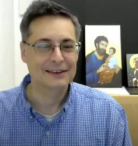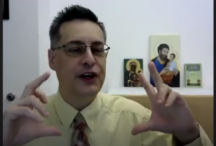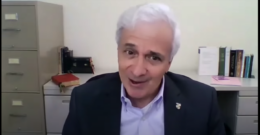Is modesty an objective thing? Should women wear skirts and dresses or risk immodesty? Is a woman who refuses to veil in church guilty of a sin? What about wearing yoga pants in public? Is it possible for a man to dress immodestly? My guest is traditional Catholic Jessica Impson and we discuss these and many other questions in this controversial episode. Like and share if you enjoy our content. You can reach Jessica at: https://www.facebook.com/groups/27337…
Author: David Cassman
Louis Tofari on Lenten Fasting and Traditions – WtT Episode 27
In this fascinating interview, you’ll learn: -What the Church really requires about fasting and abstinence -The important distinction between purple and violet in the liturgical life of the Church -When does Lent really end? Is it on Good Friday? At the Easter Vigil? The first mass of Easter morning? -Is it a sin to break your personal Lenten vow? And much more. Louis also shares some great reading recommendations.
WtT Ep 26 -The Little Known and Likely Most Relevant Marian Apparition for Our Times
In this extraordinary interview, you’ll learn about the 17th-century apparitions that few people know about, including Our Lady’s prophecies: -A swarm of heresies and near-total loss of faith in the 19th and 20th centuries -An attack on the sacrament of matrimony -Impurities that would overwhelm society -The reduction of religious orders such that almost none would remain -Horrific scandals among the priesthood that would cause the world to hate the Church And a time when a prelate and father would be silent when his children need him most. This may be the most important episode we’ve done yet.
Advent Catholic Traditions with Louis Tofari; WtT-Ep 23
Louis Tofari joins us for a fantastic conversation about the origins of Advent, the differing traditions over the centuries, and some fascinating insights, including: -Is the Advent wreath legitimately Catholic -Is Advent based on a Roman pagan practice -Why do we have rose-colored vestments on Gaudete Sunday -True origin of nativity scene (it’s not St Francis) And even the kind of wood that was used for the crib of Our Lord. Like and share this episode if you enjoyed it. Don’t forget to subscribe so you’ll be notified of new episodes. Additionally, you might like these publications referenced during the episode: -2023 Roman Calendar https://www.romanitaspress.com/produc… -Mystery of Christmas https://www.romanitaspress.com/franci… All these books are available from https://www.romanitaspress.com/
Ember Days with Louis Tofari; WtT-Ep 19
In this fascinating discussion, guest Louis Tofari covers a wide range of topics, including: -Ember Days -The origin of the-Gregorian Calendar -The truth about Galileo -Rogations -Sola Scriptura -Justification -Predestination -The Catholic origins of Tempura And even why you should eat pork on St Mark’s Feast Day. It’s a long one but a great one! Be sure to visit Louis at RomanitasPress.com
Welcome to Tradition – Episode 14 – Gregory DiPippo and the 1955 Holy Week Reforms
In this episode, you’ll hear Gregory DiPippo explain why he believes the 1955 reforms to the Holy Week liturgies formed the groundwork for the Novus Ordo reforms that would come 14 years later. We talked about: -The major changes to the liturgy -Anibale Bugnini’s role -Archbishop Lefebvre’s decision to accept the 1955 reforms -The leading role sedevacantists have played in opposing the 1955 reforms And of course, much more. If you want to learn about liturgy, join us!
Welcome to Tradition – Episode 13 – Are Canonizations Infallible?
In this episode, we discuss: -Whether canonizations are infallible -If you are allowed to doubt a canonization -The difference between a ‘saint’ and a ‘canonized saint’ -If you are allowed to pray to Archbishop Marcel Lefebvre This was a great conversation! Please join us.
QUASIMODO (LOW) SUNDAY: Grace Notes: Why we sing what we sing
Strictly speaking, Paschaltide is the liturgical season that lasts fifty days, starting with First Vespers of Low Sunday and ending before First Vespers of Trinity Sunday. Liturgically speaking, the 8-day period immediately after Easter and prior to Paschaltide – the Octave of Easter – is distinct from Paschaltide.
For our purposes, we can consider both of these periods as similar because of the musical characteristics that are common to both and that distinguish them from the previous seasons of Septuagesima and Lent, and within Lent, Passiontide, Holy Week and the Triduum.
The most conspicuous aspect of the music during the period after Easter is the return of the Alleluia. There are a number of other very visible differences, but the Alleluia stands out.
The Gloria disappeared at the same time as the Alleluia, way back on Septuagesima Sunday, and it returns fully with the Paschal Vigil. But the Gloria had also put in an appearance on Palm Sunday and again on Holy Thursday – with the organ – and with bells!
The organ also returns at the Paschal Vigil. It had disappeared beginning on the first Sunday of Lent, but it, too, put in a couple of appearances. It was used throughout the Mass on Laetare Sunday, and put in a cameo appearance (to accompany the Gloria) on Holy Thursday.
The Gloria Patri is also back. It had been omitted during Passiontide, but we saw it conspicuously when it concluded the psalms that are sung during the distribution of palms on Palm Sunday.
We sang Mass XVII all during Lent, but we made an exception on Holy Thursday, singing Mass IV. Beginning at the Paschal Vigil, and continuing through and including Pentecost, we sing Mass I (Lux et Origo).
The Alleluia, on the other hand, ceased to be sung on Septuagesima Sunday, and not a trace of it was heard until after the Epistle at the Mass of the Paschal Vigil. It didn’t show up on Laetare Sunday. There was no hint of it either on Palm Sunday, nor on Holy Thursday. It was definitively removed from the liturgy and there were no exceptions. The Alleluia, as an exclamation of pure joy, has no place whatsoever in the liturgy, nor on our lips, during those 63 days from Septuagesima to Easter. But when it returns, it is everywhere! *
At Mass, the typical Gradual and Alleluia are replaced by two Alleluias! Alleluias are inserted in the Introit, and in the Offertory and Communion antiphons.
There is another noteworthy difference in the music after Easter. The Vidi Aquam replaces the Asperges prior to Mass, and the usual invocation (Ostende nobis) and its response conclude with an Alleluia.
Interestingly, the psalm that is sung during the Vidi Aquam is the Confitemini, the same that is sung after the Alleluia makes its first trifold appearance in the Paschal Vigil.
The difference between the music of Lent and that of the period after Easter is remarkable, principally because of the Alleluia, but for many other reasons as well. All of them together help us appreciate the meaning of the Resurrection, and the joys of Easter, in contrast with the meaning of Lent, and the sorrows of the Passion. The musical beauty of the liturgy is nowhere more apparent than it is in the contrast that the liturgy offers us during these two seasons.
This Sunday is known as Quasimodo Sunday as that is the first word of the Introit. It is also called Low Sunday.
We sang Rejoice O Mary, Heavenly Queen for the processional and our now standard Stella Stella Coeli Extirpavit at the Offertory.
At the Communion, we sang the Sequence from Easter Sunday, Victimae Paschali, then O Filii et Filiae. For the recessional the OTHER version of Jesus Christ is Risen Today.
We are planning to sing a new hymn, Sweet Sacrament Divine, at first communions in a few weeks, so after the recessional, the choir sang that so that the congregation will start to learn the melody.
* An interesting side note (pun intended): Those of us in the schola and choir must rehearse for the Easter liturgy, and so, of necessity, in the depths of Holy Week, we find ourselves practicing hymns with the word Alleluia in them. We try not to put our hearts in it though. The liturgical lives of those who sing in the schola and choir are lived about two weeks in advance of what is on the liturgical calendar.
In the image: In Victor Hugo’s novel, Quasimodo, rejected by his parents for his deformities, is abandoned inside Notre Dame Cathedral, at a place where orphans and unwanted children were dropped off.
Monseigneur Claude Frollo finds the child on “Quasimodo Sunday” and “called him Quasimodo; whether it was that he chose thereby to commemorate the day when he had found him, or that he meant to mark by that name how incomplete and imperfectly molded the poor little creature was,” Hugo wrote.
THIRD SUNDAY AFTER EASTER: Grace Notes: Why we sing what we sing
We had something of a collision of ceremonies at our humble chapel this Sunday. Normally, it being the Second Sunday of the Month, the Holy Name Men would make their observances. But we also had first Communions so the Holy Name Men were requested to stand down. And so, we did.
We are still running standard fare for Paschaltide: Mass I, Credo I, Vidi Aquam.
For the processional, we did Immaculate Mary with the Fatima refrain. It’s not that it’s inappropriate. On the contrary, it being the month of Our Lady. We might rather have done an Easter hymn. But we have May procession next week, and the lovely little girls are more familiar with the Lourdes refrain. Unfortunately, the hymn sheets we have already printed have the Fatima refrain, so we wanted the girls to hear the Fatima refrain one time before next week. Yes, sometimes our choices have very practical motives.
At the Offertory, yet again, Stella Coeli Extirpavit. It is well that it is so pretty, else we would tire of it.
At the communion, Adoro Te, and a sop to the Holy Name Men, Jesu Dulcis Memoria.
For the recessional, we sang Sweet Sacrament Divine and it was well sung, our efforts to indoctrinate the faithful having paid off handsomely.
Welcome to Tradition – Episode 12 – The Unpopular truth about the Divine Mercy
If you’ve heard about the Divine Mercy and asked yourself, “What’s going on with that?”, this is the episode for you! If you think you’ve already heard everything there is to be said about this…you’re in for a surprise. Jim did a deep dive on Sister Faustina, the Diary, the painting, the chaplet and the liturgical devotion. This is one episode you will not want to miss.









